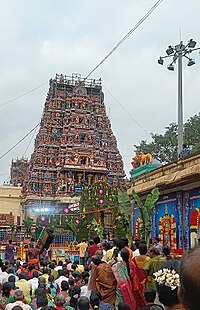Koodal Azhagar Temple
| Koodal Aḻagar Temple | |
|---|---|
 | |
| Religion | |
| Affiliation | Hinduism |
| District | Madurai |
| Deity | |
| Features |
|
| Location | |
| Location | Madurai |
| State | Tamil Nadu |
| Country | India |
| Geographic coordinates | 9°54′51.83″N 78°06′50.79″E / 9.9143972°N 78.1141083°E |
| Architecture | |
| Type | Dravidian architecture |
| Elevation | 145 m (476 ft) |
| Website | |
| www | |
Koodal Aḻagar Temple in
A granite wall surrounds the temple, enclosing all its shrines. The temple has a five-tiered raja
Koodal Aḻagar is believed to have appeared to slay the demon Somuka who abducted the four
Legend

As per Hindu legend, a ruler named Vallabhadeva went incognito everyday to know about the lives of people under him. During one of his visits, a scholar told him that the ultimate goal in life is to "collect provisions in summer and save for winter", which also meant that one should work during his younger days and save for his old age. Vallabadeva was not convinced and he set this as a competition among scholars to make him realize the true value of life. Vishnucitta, who would later go on to become
History
The inscriptions in the temple refer the presiding deity as Koodal Alagiya Perumal. There are inscriptions in the temple indicating generous gifts and endowments in the form of land, houses and gold to maintain and administer the temple. An inscription from the 8th century indicates the donation of granite stones for the construction of Ardha
Architecture

Koodal Aḻagar temple covers an area of about 2 acres (0.81 hectares) and has a five-tiered
The shrine of the consort of Koodal Aḻagar, Mathuravalli, is located to the south of the main shrine. There are smaller shrines of Lakshmi Narasimha,
Religious significance
The place is mentioned to be significant during four ages namely,
Literary mention

Historians are of the opinion that Koodal Aḻagar temple finds mention in
Koodal Purana details the origin of
Satyavrata, a ruler of Madurai was a staunch devotee of Vishnu. It is believed that once Vishnu came out of the river Krithimala as a fish (
Religious practices

The temple follows the traditions of the
The fourteen day annual Brahmotsavam during the Tamil month of Vaikasi (May - June) is the most prominent festival of the temple. The festive images of the temple are brought in chariot round the streets of the temple in various mounts during all the fourteen days.[10]
Kumbhabhishekham

The kumbabishegam of the temple was held on 20 January 2024.[12]
References
- ^ M. S., Ramesh (1993). 108 Vaishnavite Divya Desams: Divya desams in Pandya Nadu. Tirumalai-Tirupati Devasthanam.
- ^ a b c d e f M., Rajagopalan (1993). 15 Vaishnava Temples of Tamil Nadu. Chennai, India: Govindaswamy Printers. pp. 119–128.
- ^ Hindu Religious and Charitable Endowments Act, 1959
- ISBN 978-81-87952-12-1.
- ISBN 978-81-88661-42-8.
- ^ V., Meena. Temples in South India. Kanniyakumari: Harikumar Arts. p. 15.
- ISBN 9788184950243.
- ^ "Koodal Azhagar Temple tank to be renovated". Madurai: The Hindu. 27 February 2014. Retrieved 29 October 2015.
- ^ S., Sundararajan (6 September 2004). "Symbol of togetherness". The Hindu. Archived from the original on 27 November 2004. Retrieved 29 October 2015.
- ^ a b "Koodal Azhagar temple". Dinamalar. 2014. Retrieved 31 May 2014.
- ^ Rajarajan, R.K.K. (1997). "Iconographic Programme in Temple Cars: A Case Study of the Kūṭal Alakar Tēr". East and West, ROme. 48.3-4: 48.3–4: 329–48.
- ^ மதுரை கூடல் நகர் கூடலழகர் பெருமாள் கோயில் கும்பாபிஷேகம், ஜோதி டிவி, 20 சனவரி 2024

